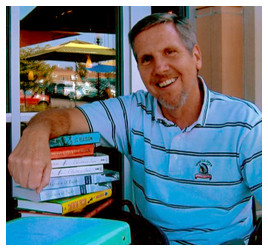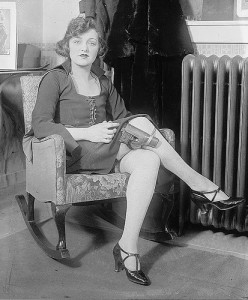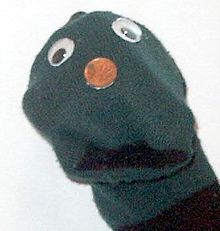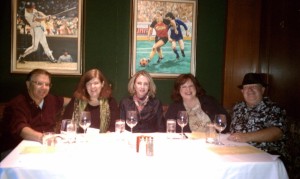Monthly Archives: October 2012
My Hemingway Connection
by Mark Alpert
As I mentioned in my last post, I take my family to northern Michigan every summer to visit my in-laws, who have a place on Little Traverse Bay. A few years ago my father-in-law casually asked me, “Would you be interested in meeting Ernest Hemingway’s nephew? He’s a heck of a nice guy.” Well, of course I was interested! Hemingway is a touchstone for all writers of fiction, but his influence is particularly strong for thriller writers. His short story “The Killers” is often cited as one of the first examples of “hard-boiled” fiction (although some academics argue that it was Dashiell Hammett who influenced Hemingway and not vice-versa). What’s more, after all our time in northern Michigan I felt a bit of geographical kinship with Hemingway, who spent the summers of his youth at his family’s cottage on Walloon Lake, just a few miles from Little Traverse Bay. The area became the setting for most of the Nick Adams stories as well as The Torrents of Spring, Hemingway’s early novel set in Petoskey, Michigan.
Hemingway’s favorite sibling was his sister Madelaine, nicknamed Sunny, who was five years younger than Ernest. She was the model for Littless, Nick Adams’s devoted younger sister in the unfinished story “The Last Good Country.” When she had a son in 1938. she named him after her famous brother. Ernest Hemingway Mainland, though, didn’t become a writer; instead he went into the insurance business in Petoskey. My father-in-law got to know him because they were both members of the Petoskey Rotary Club.
We set up a lunch to meet Ernie Mainland and his wife Judy. I’m happy to report that they’re wonderful people. Ernie has a face like his uncle’s, squarish and ruddy. The resemblance is especially striking if he’s growing a beard. He’s also a terrific storyteller. Although he hasn’t written any famous novels, he’s passionate about his family’s history, and he’s invested lots of time and energy in the restoration of Windemere, the Hemingway summer cottage, which Ernie inherited. Over lunch he told us the story of how he rebuilt the cottage’s porch, taking great care to match the way it looked during Hemingway’s boyhood. I asked Ernie what he remembered about his uncle, but he didn’t have much to say about that; he met Hemingway only once, during a visit to Cuba when Ernie was nine years old. Still, it was a great lunch, and at the end Ernie promised to invite us to Windemere the following summer.
This was a rare opportunity. Windemere isn’t open to the public. So when the next summer rolled around, my wife and I happily accepted Ernie’s invitation. The best moment, as I remember it, was taking that first step into the cottage and seeing the fireplace in the center of the room. I really felt like I’d just stepped into a Nick Adams story. Specifically, “The Three-Day Blow,” the story in which Nick and his best friend Bill get drunk on whiskey while talking about Nick’s breakup with his girlfriend Marjorie. On the cottage’s walls are all sorts of amazing things: oil paintings done by Hemingway’s mother, pencil lines showing Ernest’s height at various ages, a battered medal worn by Hemingway when he was wounded in Italy. There are also shelves holding century-old books and pamphlets, the eclectic collection of reading materials that young Ernest probably perused during rainy summer afternoons when he wasn’t hunting or fishing or carousing. As I gazed in wonder at the shelves, an idea occurred to me. I’d brought along copies of my own novels as gifts, so I asked Ernie to shelve them next to Hemingway’s. That was deeply satisfying.
Last year Ernie told me that the Hemingway Society was going to hold its 2012 conference in Petoskey to celebrate the author’s ties to northern Michigan. It was an academic conference, with most of the talks given by professors and grad students, but I really wanted to participate. As it turned out, it wasn’t that difficult to get invited; I just proposed a topic — “Hemingway and the Modern Thriller” — and they put me on the schedule. (They identified me as an “independent scholar,” which was very generous.) I was planning to speak extemporaneously, which is what I do when I talk about my novels, but my professor friends were aghast. “You can’t just wing it!” they said. “You have to deliver a paper!” So I wrote a ten-page paper analyzing Hemingway’s influence on Lee Child. Although I don’t know Hemingway nearly as well as the academics do, I figured I was better versed on bestselling thrillers, so I could pretend to be an expert.
The paper was a big hit. I got lots of laughs, and not all of them were at my expense. But the real highlight of the summer came a couple of months later when Ernie and Judy invited us to Windemere again. This time we brought along our kids, and Ernie entertained them by letting us fire his signal cannon. It’s the kind of cannon typically used to start a sailing race; you load it with blank shells and fire it by pulling on a string. (And don’t forget to cover your ears!) While we played with the miniature artillery piece, Ernie told us a story about how it had proved useful. Not so long ago, he said, a pontoon boat full of partying vacationers was looking for an anchorage spot along the shores of Walloon Lake. Now, it’s not so pleasant when one of those party boats is anchored near your property. The noise kind of spoils the idyllic atmosphere. So when Ernie saw the boat approach his shoreline, he brought out the signal cannon and fired it from his porch. The boat’s captain wisely chose another location.
The story reminded me of Hemingway. Ernie had inherited his uncle’s cheerful pugnacity. It was a delight to see.
Reader Friday: Which literary character would you be for Halloween?
To get your inspiration engines started, here’s a link to some literary character costumes squidoo.com
http://sweet-green-tangerine.blogspot.com/2012/10/thebookchat-literary-costume-ideas.html?showComment=1350347463066
Here’s a challenge–let us know which literary character you choose for Halloween! And of course, you’ll need to send us pictures! You can send your photos to Killzoneblog at gmail dot com.
Et Tu, Amazon?
So I just emerged from my editing cave (my second draft of book 2 for the PERSEF0NE trilogy is done- whew) to some disturbing news. Digging through a backlog of emails, I came across a few from fans that were extremely troubling. Apparently these fans tried to submit reviews of my book on Amazon, and their reviews either a) never appeared, or b) were abruptly taken down.
Two of the fans send transcripts of the reviews, and they were standard (and positive, thankfully): nothing offensive at all in terms of content.
One of the fans took the time and trouble to write to Amazon, asking why his review was removed. He received this form letter reply:
I’m sorry for any previous concerns regarding your reviews on our site. We do not allow reviews on behalf of a person or company with a financial interest in the product or a directly competing product. This includes authors, artists, publishers, manufacturers, or third-party merchants selling the product.
We have removed your reviews as they are in violation of our guidelines. We will not be able to go into further detail about our research.
I understand that you are upset, and I regret that we have not been able to address your concerns to your satisfaction. However, we will not be able to offer any additional insight or action on this matter.
Now, I’ve known this fan for years–he’s read (and reviewed!) all of my other books. And he has no financial stake in my work. He also doesn’t sell anything on Amazon, ever–never mind competing products (which would be what, exactly? Other books? Does this mean that I’m no longer allowed to review thrillers by my contemporaries?)
From there, it became even more disturbing. When the fan wrote back and pointed out that he’s never sold anything on Amazon, and doesn’t have any financial interest in my books, they sent another letter–and in this one, the powers that be declared that if he tried to contact them again about reposting, they would REMOVE MY BOOK FROM THE SITE.
That’s right, remove my book. Even though, had he not written, I wouldn’t have a clue that any of this was transpiring.
Hello, Big Brother.
Needless to say, I found this very disturbing, particularly since it doesn’t appear to be an isolated case. After all, two other fans sent similar messages; and I can only wonder how many others had the same experience, but didn’t write to let me know.
All I can think is that this is some sort of misguided attempt by Amazon to try and remedy some of the abuses that came to light in the recent sock puppet debacle (and if you missed all that drama, here’s a link to catch you up). But if so, it’s overkill. These days, with fewer review outlets available to writers, those Amazon reviews can be worth their weight in gold. And on what basis is Amazon is deciding that some posts should be barred? It’s very disturbing.
Thoughts?
Et Tu, Amazon?
So I just emerged from my editing cave (my second draft of book 2 for the PERSEF0NE trilogy is done- whew) to some disturbing news. Digging through a backlog of emails, I came across a few from fans that were extremely troubling. Apparently these fans tried to submit reviews of my book on Amazon, and their reviews either a) never appeared, or b) were abruptly taken down.
Two of the fans send transcripts of the reviews, and they were standard (and positive, thankfully): nothing offensive at all in terms of content.
One of the fans took the time and trouble to write to Amazon, asking why his review was removed. He received this form letter reply:
I’m sorry for any previous concerns regarding your reviews on our site. We do not allow reviews on behalf of a person or company with a financial interest in the product or a directly competing product. This includes authors, artists, publishers, manufacturers, or third-party merchants selling the product.
We have removed your reviews as they are in violation of our guidelines. We will not be able to go into further detail about our research.
I understand that you are upset, and I regret that we have not been able to address your concerns to your satisfaction. However, we will not be able to offer any additional insight or action on this matter.
Now, I’ve known this fan for years–he’s read (and reviewed!) all of my other books. And he has no financial stake in my work. He also doesn’t sell anything on Amazon, ever–never mind competing products (which would be what, exactly? Other books? Does this mean that I’m no longer allowed to review thrillers by my contemporaries?)
From there, it became even more disturbing. When the fan wrote back and pointed out that he’s never sold anything on Amazon, and doesn’t have any financial interest in my books, they sent another letter–and in this one, the powers that be declared that if he tried to contact them again about reposting, they would REMOVE MY BOOK FROM THE SITE.
That’s right, remove my book. Even though, had he not written, I wouldn’t have a clue that any of this was transpiring.
Hello, Big Brother.
Needless to say, I found this very disturbing, particularly since it doesn’t appear to be an isolated case. After all, two other fans sent similar messages; and I can only wonder how many others had the same experience, but didn’t write to let me know.
All I can think is that this is some sort of misguided attempt by Amazon to try and remedy some of the abuses that came to light in the recent sock puppet debacle (and if you missed all that drama, here’s a link to catch you up). But if so, it’s overkill. These days, with fewer review outlets available to writers, those Amazon reviews can be worth their weight in gold. And on what basis is Amazon is deciding that some posts should be barred? It’s very disturbing.
Thoughts?
The role of the publicist
Today, my guest is Tom Robinson, an independent publicist (as opposed to an in-house publicist at a publisher) based out of Nashville, TN and representing such great authors as Tasha Alexander, CJ Lyons, Laura Caldwell, and JT Ellison. Tom and I not only share a great love of writers and the art of writing, but we share the same hometown: Pensacola, FL. When we’re not chatting about the state of the publishing industry, we’re comparing lists of favorite places to eat along the Gulf Coast. I asked Tom to cover the basic question of the role of a publicist, a question that continually comes up in the discussion of writing and publishing.
———————-
By Tom Robinson
Independent Publicist
 So what does the independent publicist do for an author?
So what does the independent publicist do for an author?
It’s a question which gets asked up front when I talk with an author for the first time. It should always be the first question.
The objective is to promote the book (assuming I’m approached when the author has a new release on the horizon) and the author’s branding so that the name has recognition beyond the new book. Those are the important goals. I said “assuming” the author has a new release. I’m also seeing authors who want to continue publicity efforts while they are between books to stay in front of readers.
But let me get back to authors with a new book.
In a nutshell: from meeting with the author the publicist develops a plan to work from that will outline the use of press material, the engagement of blogs, interviews, reviews, social media, online advertising all geared to the author’s targeted audience. Social media has opened up the publicity avenues by leaps and bounds. It is an extremely successful messenger when used correctly.
The independent publicist is often extending the efforts of the publishing house. In-house publicists are usually juggling several titles. They are often understaffed and burning up long work weeks.
Beyond the plan implementation, it’s essential for the publicist to make follow up contact with targeted media outlets. That’s where so much effort is spent.
When the project is completed there should be a cross section of media coverage.
My job has seen incredible change since I first worked exclusively with authors seven years ago. I think it will continue to change, just as the publishing industry changes. But the goals will remain the same—promote the new book and the author brand.
Tom Robinson is an independent publicist for authors. Located in Nashville, TN. Robinson, a media veteran of more than three decades, works with authors of mysteries, suspense, and thrillers as well as authors of non-fiction and children’s books. He now also has his first cookbook author which is resulting in an expansion of his culinary attempts. You can find him at www.authorandbookmedia.com
Ghosts and gremlins on the road
I love soaking up ghost legends and local lore when I’m on the road. The family and I spent most of last week at the gorgeous Hotel Del Coronado in San Diego, which is known for its resident ghost: Kate Morgan, aka “Beautiful Stranger.”
Evidently Kate checked into the hotel in 1892, and committed suicide by shooting herself in the head five days later. Presumably the cause was a failed love affair (is there ever a better reason?) Ever since Kate’s passing there have been repeated sightings of her ghost, plus numerous mishaps and phenomena attributed to her restless spirit.
We may have had our own run-in with Kate’s ghost last week. At the end of a musical show in the main ballroom, the sound system mysteriously went out just as the chorus was reaching the climax of their finale. Someone said a drunken salesman had tripped over a cable, but the rest of us suspected Kate was a music critic.
Is your hometown the source of any local legends or ghost stories? Have any of them made their way into your fiction?
Note: I had a devil of a time getting this post done on my iPad–I battled gremlins galore, plus the one picture I had of Kate Morgan mysteriously failed to display in the post. You draw your own conclusions.
On the Move
So my family and I are about to embark on yet another adventure – just two years after coming back to Australia (after 15 years away) we are now heading back to the USA – to Denver this time – and I am up to my eyeballs in organization and packing (which may or may not explain my current dazed state!). Thankfully final revisions to my manuscript are done and have met with my agent’s approval so, at least on the writing front, things are more or less out of my hands. Apart from that, however, chaos reigns!
We are all very excited about the move and I’m especially looking forward to getting back into the writing community and attending some writing conferences next year. So my question for you all (as I raise my head above the parapet of boxes) is which conferences do you think are the most worthwhile? I’ve attended many in the past but I confess I’ve lost track of most of them by now and it would be great to get feedback from you all on which you attended, which you thought were great (or not so great…), and why.
I’ve already got Bouchercon down on my list – though I do find it a little large and overwhelming – but other than that I’m wide open as to options. My current manuscript is a YA one with a historical/fantasy bent but I also hope to have a traditional mystery out by early next year too.
So I’d love you all to weigh in on some of the conference options – then I can get even more excited about my return to the USA!
How to Write a Novel in a Month







